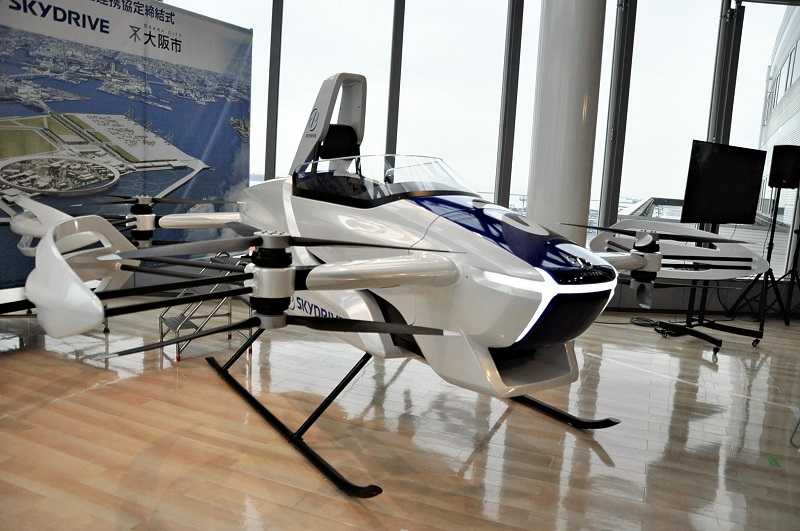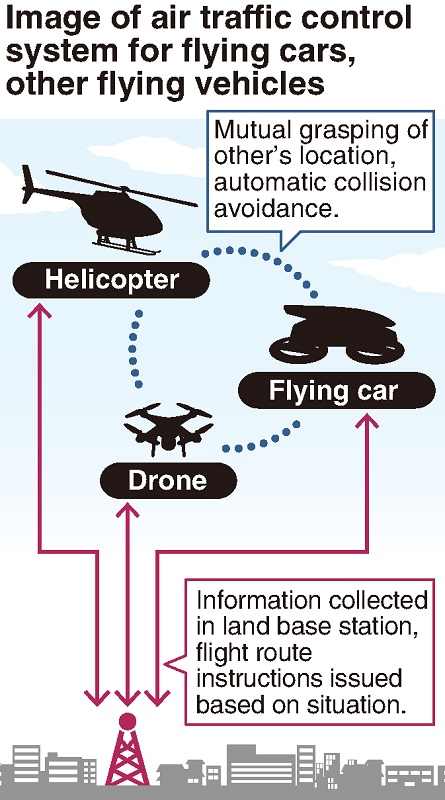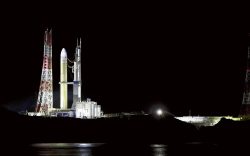
A flying car of the type that is under development for use during the 2025 Osaka-Kansai Expo
13:44 JST, October 2, 2021
Looking ahead to a future when helicopters and unmanned drones share the skies with flying cars, the government is developing traffic control technology to prevent midair collisions.
The aim is to create a system that centrally manages the flight information and controls the airspace of such vehicles, much like what is done for commercial aircraft.
By establishing a safe flight traffic environment, the government hopes to take the lead in the global competition to develop flying vehicles.
Currently, with the exception of certain airspace for helicopters, there is no centralized traffic control system for drones and flying cars, which is being seen as increasingly necessary.
From the next fiscal year, the government, in cooperation with communications equipment and flying vehicle manufacturers, will start development of technology that instantly ascertains through communications such information as the location and surrounding conditions of flying vehicles.
A land base station will collect the information and provide flight route instructions when multiple vehicles are heading for the same landing site or other situations. For crowded airspaces, the envisaged technology will enable each vehicle to determine the others’ locations to automatically avoid collisions.
The government will use know-how derived from its development of a control system to prevent accidents among multiple drones sharing airspace, and will encourage manufacturers to build vehicles that can respond to the new system.
In parallel with the technical aspect, the government will also create emergency flight rules to avoid collisions.
Drones are allowed to fly no higher than 150 meters in principle, while helicopters usually navigate at altitudes of 300 to 400 meters above buildings. Flying cars, which will be able to take off and land on building rooftops, are expected to fly at altitudes of 100 to 250 meters.
So while they all will usually operate at different altitudes, they are likely to be at the same altitude during takeoff and landing and in cases of emergency.
At present, drones are used mainly for aerial photography and filming, but are expected to find further applications, such as transporting cargo or checking and surveying infrastructure such as bridges. Remote control technology is progressing and, during the next fiscal year, the government plans to permit drones to be flown over built-up areas.

Moreover, flying cars are expected to be used for transporting cargo between remote islands from 2023, and during the 2025 Osaka-Kansai Expo, to connect Yumeshima Island, the man-made island that will host the Expo, with Kansai International and Kobe airports.
A number of countries are developing their own flying cars and creating rules to ensure safe flight.
The flying cars themselves look less like a car than an ultralight helicopter. There is no strict definition of what a flying car entails, but companies are developing them with three criteria: 1) electric-powered, 2) vertical takeoff and landing, and 3) a self-driving option.
They are also called UAM (Urban Air Mobility) in the industry.
"Science & Nature" POPULAR ARTICLE
-

Mass Oyster Die-Offs Confirmed in Japan’s Seto Inland Sea; High Water Temperature Cited as Primary Cause
-

Genome Study Reveals Milestone in History of Cat Domestication
-

Big Leap in Quest to Get to Bottom of Climate Ice Mystery
-

Security Camera Footage Vulnerable to Outside Access; Investigation Finds 3,000 Pieces Exposed Online
-

Paws on Parade: Nairobi’s Dogs Dazzle at ‘Pawchella’
JN ACCESS RANKING
-

Keidanren Chairman Yoshinobu Tsutsui Visits Kashiwazaki-Kariwa Nuclear Power Plant; Inspects New Emergency Safety System
-

Imports of Rare Earths from China Facing Delays, May Be Caused by Deterioration of Japan-China Relations
-

University of Tokyo Professor Discusses Japanese Economic Security in Interview Ahead of Forum
-

Japan Pulls out of Vietnam Nuclear Project, Complicating Hanoi’s Power Plans
-

Govt Aims to Expand NISA Program Lineup, Abolish Age Restriction

























